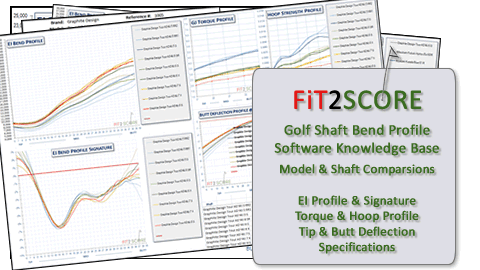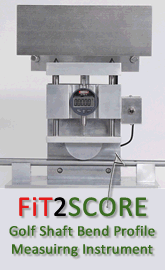Ultra Light Driver Shafts – Mitsubishi Grand Bassara
By Jim Achenbach

The new ultra-light Grand Bassara metalwood shafts from Mitsubishi Rayon are aimed at amateurs looking for increased club speed along with a definitive shaft kick in the impact zone. The key word here is amateurs. Stop me if you’ve heard this one before: Many prominent golf shafts are designed primarily for touring pros, then are lightened or softened or modified in one fashion or another for amateurs.
Sometimes this strategy works, sometimes it doesn’t. With the Grand Bassara, shaft giant Mitsubishi Rayon turned the tables. The project clearly began with the ordinary golfer and not the touring pro. This was to be everyman’s premium golf shaft.
As many of us have discovered, the best shafts for amateurs often are those that start life with more modest goals. If these shafts could talk, they might say things like this: “I always wanted to be recognized as a superlative R or S shaft, but I never took steroids and I never wanted to be confused with an X or XX guy.”
The technical discussion and measurements are available only to registered readers
During informal testing at Willamette Valley Country Club, a much-admired family club in Canby, Ore., the strongest players waggled the driver and immediately said something like, “Too whippy for me.” On the other hand, players with more moderate swing speeds were highly complimentary after hitting balls. The typical comment: “I feel the shaft helping me, and I love that.”
In recent years, shafts intended for amateurs have proliferated in the lightweight shaft arena. These shafts have moved quickly from the sub-70 category (less than 70 grams) to the sub-60, sub-50 and now the sub-40 classification. Touring pros largely remain skeptical of lightweight shafts. They associate shaft stability with heavier weights. It is the senior golfers of the world, along with women, who have been most vocal in their desire for lighter weights.
A short time after watching Rocco Mediate lose a 19-hole playoff to Tiger Woods in the 2008 U.S. Open, I approached Mediate and asked if the rumor was true. Did he really switch to a sub-60 driver shaft? “No way,” he said. “I’m strong enough to handle a heavier shaft, and most of the drivers with lightweight shafts feel to me like they’re moving and twisting all over the place.” That being said, Mediate has stayed with driver shafts in the 70s. His PGA Tour Champions victory earlier this year came with a 70-gram Aldila Rogue 60 Black X flex driver shaft.
Woods, before his prolonged absence from the PGA Tour, switched from a 93-gram Mitsubishi Rayon Diamana Blue Board to a 78-gram Matrix Ozik TP7HDe. The Matrix shaft has a suggested retail price of $1,250. Why so expensive? It is a carbon fiber shaft featuring additional materials: boron, Zylon and GMAT fiber. Although the shaft is round, it has an internal 16-sided section (called HD) that extends all the way from the butt down to the top of the parallel tip. A lot has changed in the eight years since Woods outlasted Mediate, the Grand Bassara being a prime example. It is light yet stable, especially the 39. The first thing most golfers will feel is that the shaft — and its metalwood head — are easily controllable. This usually translates into no jerking or lurching during the swing.
The Grand Bassara 39 probably will appeal to more golfers than the 29. The overall weights are 43, 45 and 48 grams for the Lite, Regular and Stiff flexes. It is the Stiff 48-gram Grand Bassara 39 that should continue to generate considerable interest among skilled older players whose swing speeds have slowed down. One more observation about club speeds: The more erratic the swing, the more erratic the speeds. Thus it is advisable to determine driver swing speeds by focusing on the best swings and discarding the results from the worst swings. Swing speeds can easily vary, depending on the quality of the swing, as much as 5 or 6 miles per hour.
The great divider between the 29 and 39 is torque. Get ready for some eye-popping high numbers for the 29. Torque ratings for the Grand Bassara 29: Lite 11.8, Regular 10.8. Torque ratings for the Grand Bassara 39: Lite 4.9, Regular 4.8, Stiff 4.7.
it always intrigues me to read what shaft manufacturers say about their own shafts. For Mitsubishi’s Grand Bassara, the theme is “Pushing the limits of lightweight (shafts) without compromising performance.” Nothing new there, but the shafts do accentuate a higher trajectory with a mid-spin profile. All the Grand Bassara shafts are made in Japan with a new proprietary carbon fiber material invented by Mitsubishi engineers. It is called MR70. According to the company, MR70 provides a 20-percent gain in strength over other fibers and a 10-percent increase in elasticity. This helps explain why the shaft is costly — the suggested retail is $450.
Grand Bassara was first earmarked for the Asian market, but is being sold worldwide. “I want to say the shaft is designed for the more classic, more traditional person,” said Mitsubishi Rayon vice-president Mark Gunther, “but many golfers can benefit from lightweight clubs. With the benefits provided by MR70, this shaft will help a lot of players.” Two fascinating developments are associated with Mitsubishi’s Grand Bassara. One, the company is working on an X flex version of the Grand Bassara 39. It is expected to be very attractive to many LPGA players. Two, the Grand Bassara is being used in Japan for fitting junior golfers and allowing them to experience what a world-class shaft feels like. I remember how excited I felt when I first played the original Bassara 43 and then went down to the Bassara 33. These were revolutionary shafts and signaled the upcoming lightweight age of golf shafts.
Many golfers have been enthralled by Mitsubishi’s multiple shaft families — the legendary Diamana, as well as Bassara, Fubuki, Kuro Kage and others. One lesson I have learned from using lightweight driver shafts: Fitting a driver with a ultra-light shaft can be tricky, and many golfers like the feel of a slightly heavier shaft. Picking a driver can be a golfer’s most difficult — yet most important — decision.
Senior golfers are leading the lightweight driver campaign. “The vast majority of our sales are lightweight, Senior flex or Regular flex driver shafts,” said Gawain Robertson, a former player on the Canadian PGA Tour and co-owner of shaft manufacturer Accra. “The average customer for many top fitters is that 65-year-old guy who wants something good and want it fitted exactly for him. That’s why we’re about to come out with a J Spec shaft with a softer tip.” This market is important enough that Mitsubishi is making all the Grand Bassara shafts in its high-end Japanese facility, where weights and frequencies must meet plus-or-minus tolerances of 1 gram or 1 CPM.
It is easy to understand why so many Asian players have gravitated to lighter shafts. “Just look at all the Asian golfers,” observed Allen Gobeski, a master fitter at Cool Clubs in Scottsdale, Ariz. “They tend to be so smooth. Their timing stays the same.” Looking at Mitsubishi Rayon, Gobeski was enthusiastic. “They are near the top of the food chain. it helps that they make their own (graphite) material.” On modern shafts in general, Gobeski remained straightforward: “There are so many good shafts out there, particularly lightweight shafts. It’s a good time to be a golfer.”
 By Russ Ryden, Fit2Score, A Dallas Fort Worth Club Fitter & Club Maker
By Russ Ryden, Fit2Score, A Dallas Fort Worth Club Fitter & Club Maker![]()
![]()




